Dear Readers,
I am pleased to say we had an extremely successful annual conference
this year in Bratislava, which saw speakers joining us from all over the
world. They addressed the whole gamut of cash questions: transport
issues, retailers' needs, the central banks and their infrastructure, as
well as cross border licencing. You will find the presentations given
at the conference on our website on the
events page.
Our Conclusion from the ESTA Conference: Cash is alive and kicking
Central Banks
- The cash playing field is a fast-changing environment, and
the ECB wants to see professional, reliable, efficient and competitive
companies as its partners.
- The French Central Bank is reshaping its infrastructure, and is
seeing increased partnership with CIT companies. A Balance Sheet Relief
Scheme is seen as necessary to trigger recirculation.
- The Central Bank of Norway has divided responsibility for cash
processing between all stakeholders which is promoting better
efficiency.
- The Belgian Central Bank has identified a model offering shared facilities to CIT and Balance Sheet Relief to the bankers.
Payments: Consumers and Retailers
- Retailers still believe cash to be cheaper for their operations
than cards. Cash remains an essential part of our economy especially for
the underprivileged and financially excluded. For them, cards are not
meeting their payment needs, and don't seem likely to in the near
future.
Banks and payment instruments
- Innovations in the ATM sector are offering new opportunities for CIT companies, such as recirculation and remittances.
Security
- IBNS has not proved to be a cure-all remedy against attacks, and
CIT companies need suppliers to research and produce more innovative
products.
- French law is being updated to cope with dramatically increasing
criminality. For this approach to be effective, it will require close
cooperation and partnership with CIT companies.
Country Updates
- The US and South African attack and loss statistics offer a stark contrast with figures from EU countries.
European Regulation
- The European Commission will review its recommendation on legal
tender. We advocate a binding directive to prevent discrimination
against cash in EU economies.
- If you want to transport cash across borders in the EU you must
request a cross border licence now, see below for our section,” Hard
facts about the EU Cross Border Regulation”.
Insurance
- The insurance market for 2011 is a benign loss environment with
plentiful capacity. Given these favourable conditions for insurers, we
would advocate lower premiums for CIT companies.
Attack and Loss
- The number of attacks against CIT services and premises is
decreasing; however, the losses are increasing. Governments need to be
pressured to place a higher priority on preventive action for protecting
our essential services.
Hard facts about the EU Cross Border Regulation
The EU Cross Border Regulation will be binding EU law from 30 November 2012.
This regulation only refers to euro cash being moved by road, between euro-area member states.
All CIT companies wishing to transport euro cash cross border from 30
November 2012 need to possess a valid cross border license that is
granted by your national licensing authorities.
Your national authorities need to be contacted to ensure they inform the
EU authorities, and CIT companies, of their choice of mode of transport
from the list provided in the regulation. CIT companies must make sure
that this choice does not have negative impacts on competition, security
or social conditions for workers.
Do not hesitate to contact us for clarification,
francis.ravez@esta.biz
Here is the text of the
Cross Border Regulation for your information.
European Central Bank Data
The following graphs and information is provided to us by the European
Central Bank. By the end of April 2012, euro banknote circulation had
been increasing at an annual rate of 4.7% (value) and 4.4% (pieces). The
ECB stated that a huge part of the currency circulation is actually
being hoarded, and that up to 25% of the circulation value is outside
the euro area.
It further states that the number of euro banknote counterfeits is low
and that virtually all euro counterfeits can be recognized without any
technical equipment and within a few seconds. It emphasizes further that
no counterfeits are capable of fooling proper sensors in banknote
acceptors or sorting machines. All of the following graphs are sourced
from the European Central Bank.
At the end of April 2012, 14.6 billion notes (equal to 874 billion euro) was in circulation, see graph below.
Regarding counterfeited notes, the ECB statistics show that 96% of all
counterfeits belong to the middle denominations of 20, 50 and 100 euro
notes. The ECB noted that the annual financial damage caused by
counterfeited euro banknotes passed in circulation has been stable
(30-40 million euros).
Circulation Development 1
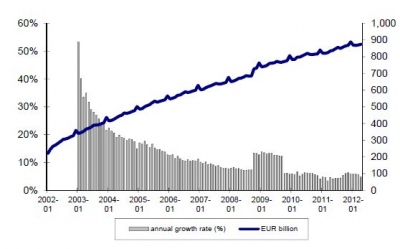
Circulation Development 2
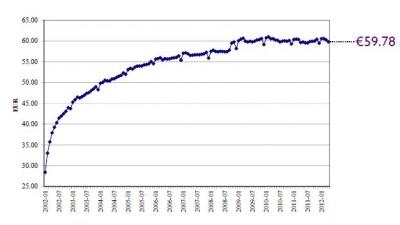
Circulation Development 3
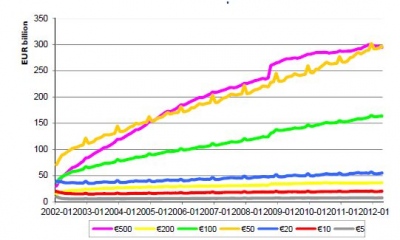
Counterfeit Development Euro Notes
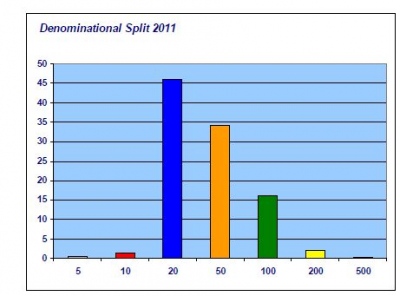
Counterfeits Development Euro Coins
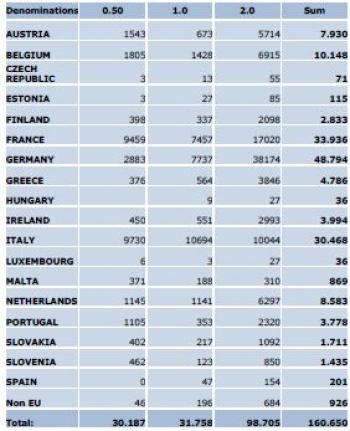

The table represents the status on euro coins counterfeiting as of 24
May 2012. This table is reproduced courtesy of OLAF, European
Commission. OLAF states that the number of counterfeit euro coins found
in circulation continued to drop and has remained well below 200 000
pieces per year, which results as one counterfeit coin for 100 000
genuine coins. OLAF goes on to say that vigilance is necessary as the
sophistication of the counterfeits has risen.
New Members
I would like to wish a warm welcome to our new members, and we were most
fortunate that they were almost all able to be with us at the
conference in Bratislava.
Effective Members Varnost Maribor – Slovenia
Associate Members Writer Safeguard Private – India
Adherent Members Feronyl – Belgium Griffin – USA
Virleo – UK CSS & Fireking International – USA Bode Panzer – Czech
Republic Romag – UK Saab – Sweden ISM2 – USA Applied DNA Sciences –
USA Sikkerhet & Forsegling – Norway
RBR Study: ATM Market in Central and Eastern Europe growing seven times faster than Western Europe
The Central and Eastern European (CEE) ATM market continued its recent
trend of strong and steady growth last year increasing by 10% in 2011.
Last year 18,000 new machines were installed in this area taking the
total to 208,000. The global recession had an impact, as has the
maturation of the market - in the mid-2000s the growth rate was 30% or
sometimes more, so the rate has in fact fallen. Even with this fall, the
level of growth is still seven times higher than in Western Europe.
These are the findings of a report published in May, 2012, by Retail
Banking Research, a London-based strategic research and consulting firm.
The report is titled “ATMs and Cash Dispensers Central and Eastern
Europe 2012” and covers 15 countries.
The growth of the ATM market in Russia is the highest – 83% of the
growth in the region as a whole came from Russia where 15,000 new ATMs
were installed, at an increase of 15%. Latvia's ATM base shrank by 13%
and a full 20% of Lithuania's ATMs were withdrawn after the bankruptcy
of Bankas Snoras, the country's third largest deployer. The new
market for ATMs which accept deposits was strong in 2011, with the
number of these machines rising by 37% to nearly 26,000 in the region.
Most are in Russia, the Ukraine, Kazakhstan, Poland and the Czech
Republic following. Even so, cash recyclers are rare with fewer than 500
installed in the whole region.
Security in the region is a growing market, and deployers have installed
security cameras at 73% of their ATMs to fight card fraud and deter
physical attacks. In Belarus 98% of terminals are equipped with security
cameras, while only Hungary, Slovenia and Croatia have fewer than 40%
of ATMs equipped.
Other statistics on security include: 96% of the region's ATMs are now
EMV-compliant, and 99% comply with 3DES security requirements. Over half
the ATMs have been fitted with anti-skimming devices, with Slovakia,
Russia and Croatia the most advanced markets. Banknote degradation in
now present in seven of the CEE markets and biometric identification has
been introduced by BPS Bank in Poland.
Upcoming Conferences
EFMA
EFMA is holding a conference and exhibition, ”The Future of Cash” on Tuesday 25 and Wednesday 26 September 2012.
EFMA
The venue: Hotel Concorde La Fayette 3, Place du Général Kœnig
75017 Paris, France Tél. +33 1 40 68 50 68 - Fax. +33 1 40 68 50 43
www.concorde-lafayette.com/en
ICCOS
The next ICCOS conference is taking place at the Hilton Hotel &
Convention Centre, Warsaw, Poland November 5-7, 2012. For more
information go to:
www.emea.iccos.com
ESTA Conference 2013
Mark the dates in your calendar now, our next conference will be from
2-4 June 2013. The venue will be sunny Marseille in southern France.
I wish to thank you again for your presence at our conference in
Bratislava, it is the good will and active participation of you, our
members, that makes the conference the unique success that it is.
Enjoy the summer vacation.






